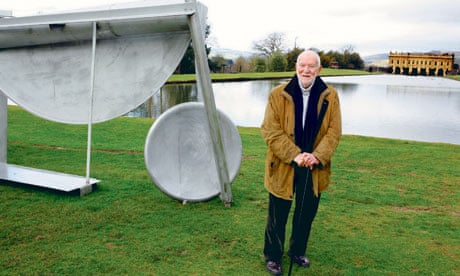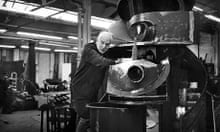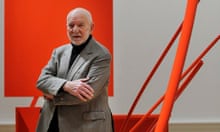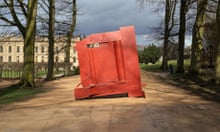In 1955 the influential art critic David Sylvester identified Anthony Caro as the best British sculptor since Henry Moore. But by 1963 he was having second thoughts. Shortly after Caro's groundbreaking Whitechapel Gallery exhibition that year, in which he had taken the then radical step of dispensing with a plinth for his abstract steel sculptures, Sylvester accompanied a group from the Royal College of Art – "in principle, the crème de la crème of Britain's sculpture students" – to see some of Caro's work at an open-air exhibition. When they got to Midday – Caro's 1960 yellow-painted assemblage of bolted-together pieces of steel, now often described as his first masterpiece and later acquired by the Museum of Modern Art in New York – "one of the brightest of them declared that he wasn't prepared to discuss the piece, as it wasn't a work of art", Sylvester recalled. The "distressing afternoon in Battersea Park" ended with a "perfunctory and embarrassed discussion of Midday during which at least half the class sulked".
Sylvester told this story – in a catalogue essay for a 1980s Caro exhibition – as an example of how "aesthetic conservatism can manifest itself where we would least expect it". And the fast-moving relationship between the radical and the conservative in the world of art has been a feature of Caro's long career as he has oscillated between the cutting edge and the establishment, depending on who you ask, and when.
"It's very difficult today to imagine what a battle there once was over these ideas and how much we upset people," Caro says. "Even over abstraction. Someone would always ask 'what's that sculpture for?' If you said it's not 'for' anything apart from looking at, there'd instantly be a big fight."
Like many revolutionaries, Caro was always, at least in part, an insider. His first job was as an assistant to Henry Moore, and he conducted his overhaul of British sculpture from a post at St Martin's school of art in London. For nearly 30 years he had significant influence over how and what art students were taught, but it was also at St Martin's that he was exposed to the sometimes brutally rapid movement of artistic evolution. Just a few years after his Whitechapel show had set sculpture on a new path and so enraged the conservatives, a new generation of students emerged – Barry Flanagan, Gilbert and George and Richard Long, among others – for whom Caro was someone to rebel against.
"That group was very much a reaction against the first group of abstract sculptors," he explains. "They were trying to find another way. And some of that was interesting. Where does art start? Where does it stop? Does it breathe? But I did also have a sense that the goalposts had somehow been moved." For all that, he says he was intrigued by some of Long's work and was "always enormously amused by Gilbert and George. They were lovely people, despite us not having much to say to each other art-wise. I remember seeing them doing their living sculpture thing and I said hello, and they ignored me. A little later they came up to me and apologised if they had appeared rude, but explained they couldn't speak because they had been busy."
In one sense, Caro's subsequent career has been essentially an establishment one. His work is in more than 175 public collections around the world, and as far back as 1976 he was presented with the key to the city of New York by the mayor. In the UK he was knighted in 1987 and made a member of the Order of Merit in 2000. But in art terms, he has remained restlessly innovative and has been a productive presence for more than 60 years.
There is now an opportunity to see four decades of Caro's work in the grounds of Chatsworth House in Derbyshire – itself a piece of radical architecture when built. "I was offered the whole of the estate, but I liked the areas nearer the house because it was formal enough to take the sculptures, and you are never looking from afar and seeing a great big sculpture on the horizon. I wanted something more intimate."
He has planned the sitings of the works at Chatsworth. Yet he says: "I always feel my job is to make the sculptures, and curating shows is really for someone else. It feels like looking backwards, and throughout my entire career I've always said, 'what's next?', not 'what's just happened?'. When I began, being a sculptor might have meant producing statues of generals on horseback. But I always pushed forward, and have had a career that would have been unimaginable even to myself back then."
Caro was born in Surrey in 1924. His father was a stockbroker, and it was assumed, although not by Anthony, that his son would follow in his footsteps. The family was Jewish and as the persecution of Jews in Germany became increasingly obvious, his mother arranged for a school friend and her three children to come to England, where Caro's father paid for the children's education. Caro says the small amount of religious education he had "didn't mean that much to me. It just seemed to say 'praise God' and I didn't know quite what that meant. I actually preferred Christian hymns and prayers, which seemed more personal. And when I went to university my friends there were mostly practising Christians." The spiritual strand in his life culminated in 2008, when he completed a nine-year project to restore and install new sculptures in a church in northern France destroyed during the second world war. "Is art so different from religion? It feeds the spirit, and through it you also try to find this inner part of yourself."
At Charterhouse School Caro did a lot of art "without much encouragement. We were not well taught and while I did do the school certificate in art, I didn't get a credit." In 1942 he went to Christ's College, Cambridge, to study engineering, which by now his father had identified as another potential career. Art was still out of the question. "But my father knew I was serious about it, so he showed my work to a teacher at, ironically as it turned out, St Martin's. He said I'd be no good and that I should just do it as a hobby. That suited my father very well as he thought artists were dilettantes and people who didn't fit in with society. And I suppose he was right there. But we still battled and battled." It wasn't until he was serving in the Fleet Air Arm at the end of the war, from 1944-46, that his father finally relented, and Caro spent the next six years having a "very traditional" art education.
While at art school he met the painter Sheila Girling, a fellow student. They married in 1949 and had two sons. His workshop and her studio still share space in a converted piano factory in Camden, north London. Shortly after getting married, Caro "pretty much just turned up" at Henry Moore's door and asked for a job. "He didn't say yes. But he did ask me in for a cup of tea and told me to come back in six months' time. Six months to the day later I rang him, and he told me I could start the following Monday." So in 1951 the Caro family moved to Much Hadham in Hertfordshire, where Caro became Moore's part-time assistant. "Henry was wonderful and taught me a great deal," he says. "We talked a lot about art, and he would look at my drawings and criticise them."
It was also while working for Moore that Caro was first exposed to Francis Bacon and Picasso. "I was shaken by them both. I saw that work needn't necessarily be like Henry's." But when Caro left Moore and returned to London, he didn't enter the louche art world scene inhabited by Bacon. "I was probably too bourgeois and focused on the art. I thought if I concentrated on the art, the rest would look after itself. I would visit my artist friends' houses and they were so tasteful and lovely. But mine was blank. I had no pictures on the walls. I said I wouldn't hang anything on my walls until I can find a painting that says to me 'do better'. In the end, I did find that sort of work and now have lots of paintings, but my whole life was around making better art."
Now ensconced in a new studio in Hampstead, Caro began to make the large, expressionistic figurative clays and bronzes such as Woman Waking Up (bought by the Tate in 1955), that prompted Sylvester to crown him Moore's successor. But in 1959 he was searching for a new approach. A trip to America, and a meeting with the critic and high priest of abstract expressionism, Clement Greenberg, helped him on his way. Greenberg advised: "If you want to change your sculpture, change your habit of working." In America Caro encountered the abstract painter Kenneth Noland and sculptor David Smith, who was already making large-scale steel works.
"I was very taken by American thinking and the whole abstraction idea. It was getting away from the English harking towards surrealism and the literary. When I do an interview in England people always want to know about Henry Moore. But when I speak in America they all want to know about David Smith. Moore was like both a parent and a teacher to me. Even though the age difference with David was similar, he would treat me much more like a competitor." The pair became so close, however, that when Smith was killed in a car crash in 1965, Caro acquired the stocks of raw materials from his workshops and shipped them back to use in England.
Caro's working and teaching lives had been conducted in parallel since 1953, when he began as a part-time tutor at St Martin's. He continued there until 1981. "It was a marvellous boon when I started. I had some money from my dad, I was being paid – albeit minimally – at Henry's, and I now taught. Working as an artist became viable and, more than that, if you teach properly then you discover things. Students ask the difficult questions and you have to think to find a proper answer to them." But it took him 10 years, and his incorporation of the influence of Greenberg and of American abstraction before his 1963 Whitechapel show could make such a remarkable impact.
The 15 abstract steel sculptures attracted some predictable complaints about "being just building materials", but their human scale, and placing of them on the ground – so removing them from the rarefied position of the plinth and bringing them down to the spectator's own space – "had made a huge difference as to how they were received", he says. "And with the use of colour I really thought we could be like the impressionists, at least in terms of what we aspired to." Caro says he was pleased that success came relatively late. "In my late 30s I was ready. If it had come to me at 25, it would have been much more difficult to handle. The idea of dealers going to degree shows and picking people out when they are 21 is jolly bad for an artist. It just puts too much extra strain on them."
Caro's long apprenticeship enabled his career to proceed apace after the Whitechapel show. A decade later he was receiving retrospectives, but he says some of the work he produced in the 70s – including some of the large "flats" of sheet steel on display at Chatsworth – "were not that well received when they were made. I think the reason was that it was quite blank work at a time when there was a taste for more readable sculpture."
There is a sense that over the years Caro's strict adherence to abstract principles have relaxed. He even, cautiously, admits that politics might have crept up on his work. "I had very strong views about something like Suez, but it had nothing to do with the work I was making at the time. But I think now, especially with television showing so much of what is going on, it does begin to seep in somehow."
His 1993-94 work called The Trojan War and his 2002 depiction of terracotta figures on wooden gymnastic horses, The Barbarians, both appear to have been informed by the first Iraq and the Yugoslav wars. "But I am still an abstract sculptor," he says. "And if there is any narrative content – if – then it is just a byproduct. The battle to make abstract art was so difficult in the past that if a work ended up looking like an insect then you'd think, 'oh my God, I didn't want it to look like an insect'. But when the battle was won, you could spread sculpture more widely without feeling guilty about it. Now, if something looks like an insect, it looks like an insect. If there is a narrative, it doesn't seem to matter half as much."
Caro turned 88 last week, and says: "I can't tell you how lazy I am these days. And even when I do start lifting something, someone else will run over and lift it for me. But as a result I have more time to make sculpture. I can tell people to try this here or there, and that way you can get a lot made." On the smallest scale, he is currently designing a gold kilo coin for the Royal Mint to mark the London Olympics. And on the large, he is preparing a huge sculpture that will occupy three blocks of midtown Manhattan later this year. He also finds himself more frequently writing for newspapers about old friends recently departed. "People very dear to me keep on dying. I really have got to put a stop to it. But I don't usually like looking back, and am surprised at how much of it goes on today. People keep badgering me to write an autobiography. I couldn't think of anything worse. I've always kept going by thinking about tomorrow, not yesterday. I'm not going to stop now."







Comments (…)
Sign in or create your Guardian account to join the discussion